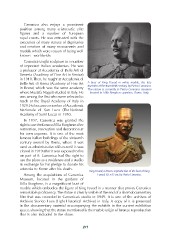Page 211 - Features of an Era
P. 211
Canonica also enjoys a prominent
position among many aristocratic elite
figures and a number of European
royal courts. He was entrusted with the
execution of many statues of dignitaries
and creation of many monuments and
medals which were reason of being well
known worldwide.
Canonica taught sculpture in a number A bust of King Fouad in white marble, the late
of important Italian academies. He was twenties of the twentieth century, by Pietro Canonica.
a professor at Accademia di Belle Arti di The statue is currently in Pietro Canonica museum
Venezia (Academy of Fine Art in Venice)
in 1910. Then, he taught at Accademia di located in Villa Borghese gardens, Rome, Italy.
Belle Arti di Roma (Academy of Fine Art
in Rome) which was the same academy
where Mustafa Naguib studied in Italy. He
was among the first who were selected to
teach at the Royal Academy of Italy in
1929. He became a member of Accademia
Nazionale di San Luca (The National
Academy of Saint Luca) in 1930.
In 1937, Canonica was granted the
right to use the famousVilla Borghese after
restoration, renovation and decoration at
his own expense. It is one of the most
famous Italian buildings of the sixteenth
century owned by Rome, where it was
used as administrative offices until it was
closed in 1919 after it was exposed to fire
on part of it. Canonica had the right to
use the place as a residence and a studio
in exchange for his pledge to donate his
artworks to Rome after his death. King Fouad, a bronze reproduction of the bust of King
Among the acquisitions of Canonica Fouad, 63 x70 cm, by Pietro Canonica.
Museum, located in the gardens of
Villa Borghese, is a magnificent bust of
marble which embodies the figure of King Fouad in a manner that proves Canonica
remarkable proficiency. The statue is clearly visible at the end of a short documentary
film that was recorded in Canonica’s studio in 1949. It is one of the archives of
Archivio Storico Luce (Light Historical Archive) in Italy. A copy of it is presented
in the documentary material accompanying the exhibits in the current exhibition
space, showing that the statue mentioned is the marble origin of bronze reproduction
that is also included in the show.
211
position among many aristocratic elite
figures and a number of European
royal courts. He was entrusted with the
execution of many statues of dignitaries
and creation of many monuments and
medals which were reason of being well
known worldwide.
Canonica taught sculpture in a number A bust of King Fouad in white marble, the late
of important Italian academies. He was twenties of the twentieth century, by Pietro Canonica.
a professor at Accademia di Belle Arti di The statue is currently in Pietro Canonica museum
Venezia (Academy of Fine Art in Venice)
in 1910. Then, he taught at Accademia di located in Villa Borghese gardens, Rome, Italy.
Belle Arti di Roma (Academy of Fine Art
in Rome) which was the same academy
where Mustafa Naguib studied in Italy. He
was among the first who were selected to
teach at the Royal Academy of Italy in
1929. He became a member of Accademia
Nazionale di San Luca (The National
Academy of Saint Luca) in 1930.
In 1937, Canonica was granted the
right to use the famousVilla Borghese after
restoration, renovation and decoration at
his own expense. It is one of the most
famous Italian buildings of the sixteenth
century owned by Rome, where it was
used as administrative offices until it was
closed in 1919 after it was exposed to fire
on part of it. Canonica had the right to
use the place as a residence and a studio
in exchange for his pledge to donate his
artworks to Rome after his death. King Fouad, a bronze reproduction of the bust of King
Among the acquisitions of Canonica Fouad, 63 x70 cm, by Pietro Canonica.
Museum, located in the gardens of
Villa Borghese, is a magnificent bust of
marble which embodies the figure of King Fouad in a manner that proves Canonica
remarkable proficiency. The statue is clearly visible at the end of a short documentary
film that was recorded in Canonica’s studio in 1949. It is one of the archives of
Archivio Storico Luce (Light Historical Archive) in Italy. A copy of it is presented
in the documentary material accompanying the exhibits in the current exhibition
space, showing that the statue mentioned is the marble origin of bronze reproduction
that is also included in the show.
211


